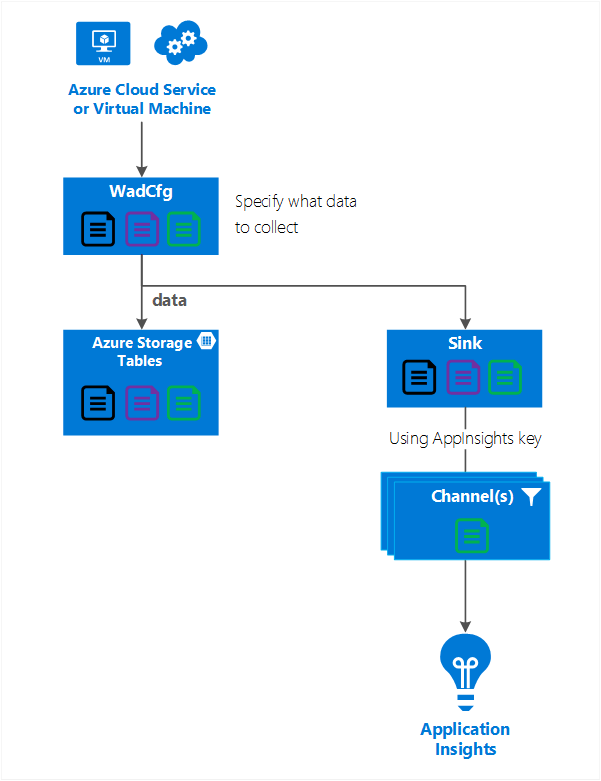Application Insights에 클라우드 서비스, Virtual Machine 또는 Service Fabric 데이터 보내기
클라우드 서비스, Virtual Machines, Virtual Machine Scale Sets 및 Service Fabric은 모두 Azure Diagnostics 확장을 사용하여 데이터를 수집합니다. Azure 진단은 데이터를 Azure Storage 테이블에 보냅니다. 그러나 Azure Diagnostics 확장 1.5 이상을 사용하여 다른 위치에 데이터의 하위 세트나 전체를 파이핑할 수 있습니다.
이 문서에서는 Azure Diagnostics 확장에서 Application Insights에 데이터를 전송하는 방법을 설명합니다.
설명한 진단 구성
Azure 진단 확장 1.5에는 진단 데이터를 보낼 수 있는 추가 위치인 싱크가 도입되었습니다.
Application Insights에 대한 싱크 예제 구성:
<SinksConfig>
<Sink name="ApplicationInsights">
<ApplicationInsights>{Insert InstrumentationKey}</ApplicationInsights>
<Channels>
<Channel logLevel="Error" name="MyTopDiagData" />
<Channel logLevel="Verbose" name="MyLogData" />
</Channels>
</Sink>
</SinksConfig>
"SinksConfig": {
"Sink": [
{
"name": "ApplicationInsights",
"ApplicationInsights": "{Insert InstrumentationKey}",
"Channels": {
"Channel": [
{
"logLevel": "Error",
"name": "MyTopDiagData"
},
{
"logLevel": "Error",
"name": "MyLogData"
}
]
}
}
]
}
Sinkname 특성은 싱크를 고유하게 식별하는 문자열 값입니다.
ApplicationInsights 요소는 Azure 진단 데이터를 보낼 Application Insights 리소스의 계측 키를 지정합니다.
채널 요소는 하나 이상의 채널 요소를 포함합니다.
- name 특성은 고유하게 해당 채널을 의미합니다.
- loglevel 특성을 사용하면 채널이 허용하는 로그 수준을 지정할 수 있습니다. 정보가 많은 순서대로 사용 가능한 로그 수준은 다음과 같습니다.
- 자세한 정보 표시
- 정보
- 경고
- 오류
- 위험
채널은 필터처럼 작동하고 채널을 사용하면 대상 싱크에 보내는 특정 로그 수준을 선택할 수 있습니다. 예를 들어 자세한 정보 표시 로그를 수집하고 스토리지에 보내지만 오류만을 싱크에 보낼 수 있습니다.
다음 그래프에서는 이 관계를 보여 줍니다.
다음 그래프에서는 구성 값 및 작동 방법을 요약합니다. 계층 구조에서 다양한 수준의 구성에 여러 싱크를 포함할 수 있습니다. 최상위 수준의 싱크는 전역 설정이며 개별 요소에 지정된 싱크는 전역 설정에 재정의와 같은 역할을 합니다.
전체 싱크 구성 예제
다음은 공용 구성 파일의 전체 예입니다.
- Application Insights에 모든 오류를 보냅니다(DiagnosticMonitorConfiguration 노드에 지정됨).
- 또한 애플리케이션 로그(로그 노드에 지정됨)에 대한 자세한 정보 표시 수준 로그를 보냅니다 .
<WadCfg>
<DiagnosticMonitorConfiguration overallQuotaInMB="4096"
sinks="ApplicationInsights.MyTopDiagData"> <!-- All info below sent to this channel -->
<DiagnosticInfrastructureLogs />
<PerformanceCounters>
<PerformanceCounterConfiguration counterSpecifier="\Processor(_Total)\% Processor Time" sampleRate="PT3M" />
<PerformanceCounterConfiguration counterSpecifier="\Memory\Available MBytes" sampleRate="PT3M" />
</PerformanceCounters>
<WindowsEventLog scheduledTransferPeriod="PT1M">
<DataSource name="Application!*" />
</WindowsEventLog>
<Logs scheduledTransferPeriod="PT1M" scheduledTransferLogLevelFilter="Verbose"
sinks="ApplicationInsights.MyLogData"/> <!-- This specific info sent to this channel -->
</DiagnosticMonitorConfiguration>
<SinksConfig>
<Sink name="ApplicationInsights">
<ApplicationInsights>{Insert InstrumentationKey}</ApplicationInsights>
<Channels>
<Channel logLevel="Error" name="MyTopDiagData" />
<Channel logLevel="Verbose" name="MyLogData" />
</Channels>
</Sink>
</SinksConfig>
</WadCfg>
"WadCfg": {
"DiagnosticMonitorConfiguration": {
"overallQuotaInMB": 4096,
"sinks": "ApplicationInsights.MyTopDiagData", "_comment": "All info below sent to this channel",
"DiagnosticInfrastructureLogs": {
},
"PerformanceCounters": {
"PerformanceCounterConfiguration": [
{
"counterSpecifier": "\\Processor(_Total)\\% Processor Time",
"sampleRate": "PT3M"
},
{
"counterSpecifier": "\\Memory\\Available MBytes",
"sampleRate": "PT3M"
}
]
},
"WindowsEventLog": {
"scheduledTransferPeriod": "PT1M",
"DataSource": [
{
"name": "Application!*"
}
]
},
"Logs": {
"scheduledTransferPeriod": "PT1M",
"scheduledTransferLogLevelFilter": "Verbose",
"sinks": "ApplicationInsights.MyLogData", "_comment": "This specific info sent to this channel"
}
},
"SinksConfig": {
"Sink": [
{
"name": "ApplicationInsights",
"ApplicationInsights": "{Insert InstrumentationKey}",
"Channels": {
"Channel": [
{
"logLevel": "Error",
"name": "MyTopDiagData"
},
{
"logLevel": "Verbose",
"name": "MyLogData"
}
]
}
}
]
}
}
이전 구성에서 다음 줄은 다음과 같은 의미가 있습니다.
Azure 진단에서 수집하는 모든 데이터 보내기
<DiagnosticMonitorConfiguration overallQuotaInMB="4096" sinks="ApplicationInsights">
"DiagnosticMonitorConfiguration": {
"overallQuotaInMB": 4096,
"sinks": "ApplicationInsights",
}
Application Insights 싱크로 오류 로그만 보내기
<DiagnosticMonitorConfiguration overallQuotaInMB="4096" sinks="ApplicationInsights.MyTopDiagdata">
"DiagnosticMonitorConfiguration": {
"overallQuotaInMB": 4096,
"sinks": "ApplicationInsights.MyTopDiagData",
}
Application Insights에 자세한 정보 표시 애플리케이션 로그 보내기
<Logs scheduledTransferPeriod="PT1M" scheduledTransferLogLevelFilter="Verbose" sinks="ApplicationInsights.MyLogData"/>
"DiagnosticMonitorConfiguration": {
"overallQuotaInMB": 4096,
"sinks": "ApplicationInsights.MyLogData",
}
제한 사항
- 성능 카운터가 아닌 로그 유형인 채널 성능 카운터 요소가 있는 채널을 지정하면 무시됩니다.
- 채널의 로그 수준은 Azure 진단에서 수집되는 로그 수준을 초과할 수 없습니다. 예를 들어 Logs 요소에서 애플리케이션 로그 오류를 수집하고 자세한 정보 표시 로그를 Application Insight 싱크로 보내려고 할 수 없습니다. scheduledTransferLogLevelFilter 특성은 항상 싱크에 보내려는 로그보다 같거나 더 많은 로그를 수집해야 합니다.
- Azure 진단 확장에서 수집한 Blob 데이터를 Application Insights로 보낼 수 없습니다. 예를 들어 디렉터리 노드에 지정된 모든 항목입니다. 크래시 덤프의 경우 실제 크래시 덤프가 Blob Storage로 전송되고 크래시 덤프가 생성되었다는 알림만 Application Insights로 전송됩니다.
다음 단계
- Application Insights에서 Azure 진단 정보를 보는 방법에 대해 알아봅니다.
- PowerShell을 사용하여 애플리케이션에 대한 Azure 진단 확장을 사용하도록 설정합니다.
- Visual Studio를 사용하여 애플리케이션에 대한 Azure 진단 확장을 사용하도록 설정합니다.

